
Browse an alphabetical list of photographs. These historical images portray people, places, and events before, during, and after World War II and the Holocaust.
<< Previous | Displaying results 1776-1800 of 2641 for "Photo" | Next >>
Polish babies, chosen for their "Aryan" features, to be adopted and raised as ethnic Germans. Poland, 1941–1943.
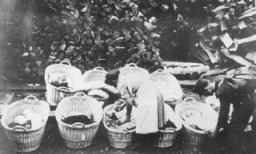
Polish children wander through the ruins of Warsaw after a German bombing. Photographed by Julien Bryan in Warsaw, Poland, ca. 1939.
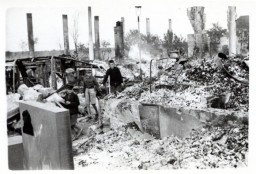
Polish civilians under SS and Selbstschutz (ethnic German self-defense organization) guard are forced to dig a mass grave prior to their execution in the forest near Tuchola. Tuchola Forest, Bydgoszcz, Poland, October 27, 1939.
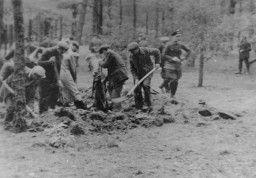
Members of a Polish family who hid a Jewish girl on their farm. Zyrardow, Poland, 1941-1942.
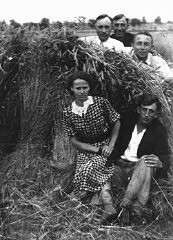
Polish hostages in the Old Market Square. Bydgoszcz, Poland, September 9–10, 1939. Just after the German invasion of Poland, armed groups of ethnic Germans in the city of Bydgoszcz staged an uprising against the local Polish garrison. This was put down by the next day, one day prior to the entrance of German troops in the city on September 5. A local command structure was quickly put into place by Major General Walter Braemer, and in response to continued attacks upon German personnel in the city,…
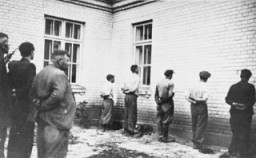
Polish Jewish orphans, under the temporary care of the United Nations Relief and Rehabilitation Administration (UNRRA), en route to France and Belgium. Prague, Czechoslovakia, 1946.
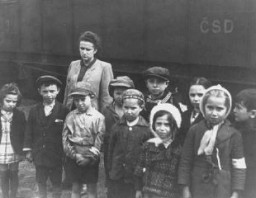
Polish Jewish refugees arriving at Babenhausen displaced persons camp, where the Joint Distribution Committee and the United Nations Relief and Rehabilitation Administration provided aid. Germany, August 20, 1947.
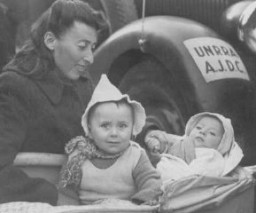
Polish-Jewish refugees seeking to leave Europe arrive in Lisbon. Following the German invasion of France, Jewish and non-Jewish refugee assistance organizations relocated their headquarters to Lisbon, the only neutral European port from which refugees could depart to North and South America. Lisbon, Portugal, June 21-22, 1940.
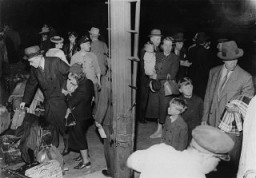
Arrival of political prisoners at the Oranienburg concentration camp. Oranienburg, Germany, 1933.
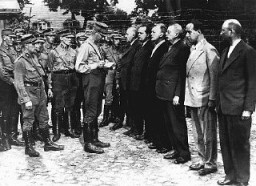
Class photograph of students at the San Leone Magno Fratelli Maristi boarding school in Rome. Pictured in the top row at the far right is Zigmund Krauthamer, a Jewish child who was being hidden at the school. Rome, Italy, 1943–44.
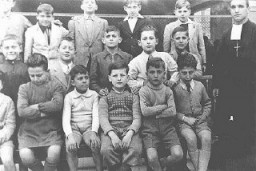
Portrait of a preschool class in Copenhagen. Gus Goldenburger (top row, second from left) was one of the few Jewish students in the class. His family moved to Denmark from Czechoslovakia, fearing the rising tide of Nazism. When the Nazis planned to deport Danish Jewry, the Goldenburgers managed to escape to Sweden, where they remained until the end of the war. After the war, the Goldenburgers returned to Copenhagen. Photograph taken in Copenhagen, Denmark, 1938–1939.
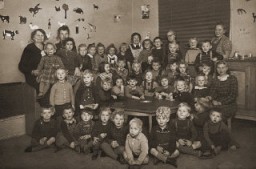
Portrait of an unidentified family of eight adults and three children in Bitola. This photograph was one of the individual and family portraits of members of the Jewish community of Bitola, Macedonia, used by Bulgarian occupation authorities to register the Jewish population prior to its deportation in March 1943.
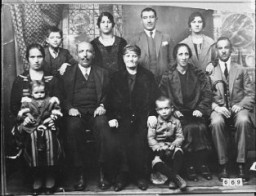
Portrait of Aron's family on his mother's side, taken when Aron's cousin moved to Israel in 1933-1934. Aron is seated second from left, bottom row. His mother, Miriam, is in the center row, second from right. Aron's father is behind her and to her right. Aron himself was 8 or 9 years old when this picture was taken in either May or June. At the time, Aron recalled, "I was thinking about going to summer camp." Slonim, Poland, 1933-1934.

Arthur Greiser, a leading Nazi Party official in Danzig. He became the head of the Danzig Senate in 1934. After the beginning of World War II, he became administrator of the new province known as the Warthegau.
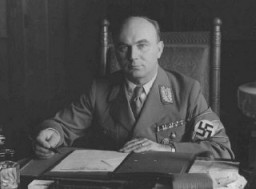
Portrait of Asael Bielski, a founder of the Bielski brothers' Jewish partisan unit in Naliboki forest. He was killed on the Soviet front in 1944. Novogrudok, Poland, before 1941.
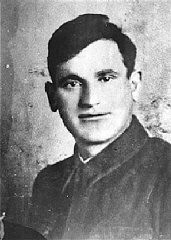
Portrait of Robert T. Odeman, author and actor who was imprisoned in 1937 for 27 months for homosexuality. In 1942, he was deported to Sachsenhausen concentration camp where he was a prisoner for three years. Berlin, Germany, before 1937.
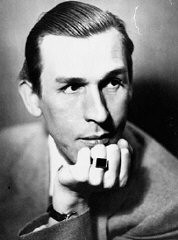
Portrait of Benjamin Meed, leading advocate for Jewish Holocaust survivors and a founder of the United States Holocaust Memorial Museum.
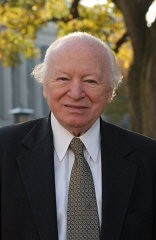
Portrait of Buena Eschkenasi, daughter of Bohor Eschkenasi. She lived at Zmayeva 10 in Bitola. This photograph was one of the individual and family portraits of members of the Jewish community of Bitola, Macedonia, used by Bulgarian occupation authorities to register the Jewish population prior to its deportation in March 1943.
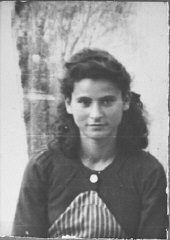
An 18-month-old Jewish boy, Chaim Leib, who was murdered at the Auschwitz killing center in occupied Poland. Bukovina, Romania, 1942.
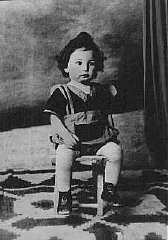
Portrait of David Aruti, son of Isak Aruti. He was a merchant and lived at Zvornitska 26 in Bitola. This photograph was one of the individual and family portraits of members of the Jewish community of Bitola, Macedonia, used by Bulgarian occupation authorities to register the Jewish population prior to its deportation in March 1943.
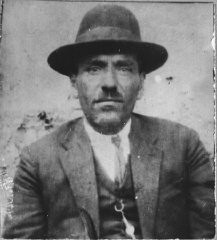
Portrait of David Kamchi, son of Masliach Kamchi, and his wife Sara. They lived at Gostivarska 3 in Bitola. This photograph was one of the individual and family portraits of members of the Jewish community of Bitola, Macedonia, used by Bulgarian occupation authorities to register the Jewish population prior to its deportation in March 1943.
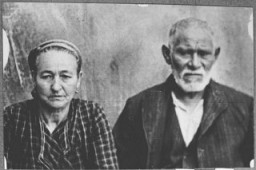
Portrait of David Pesso. He was a dealer of second-hand items. He lived at Novatska 4 in Bitola. This photograph was one of the individual and family portraits of members of the Jewish community of Bitola, Macedonia, used by Bulgarian occupation authorities to register the Jewish population prior to its deportation in March 1943.
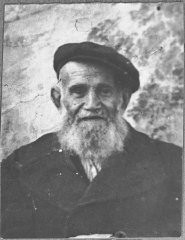
Ernest Hemingway in his World War I Red Cross Ambulance Corps uniform, ca. 1918.
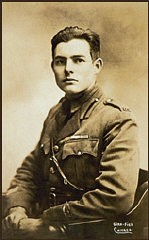
Portrait of Ester Eschkenasi, wife of Sava Eschkenasi. She lived at Karagoryeva 91 in Bitola. This photograph was one of the individual and family portraits of members of the Jewish community of Bitola, Macedonia, used by Bulgarian occupation authorities to register the Jewish population prior to its deportation in March 1943.
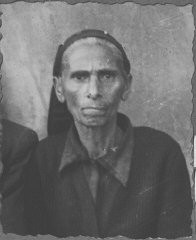
Portrait of Estreya Kolonomos, wife of Isak Kolonomos. She lived at Novatska 23 in Bitola. This photograph was one of the individual and family portraits of members of the Jewish community of Bitola, Macedonia, used by Bulgarian occupation authorities to register the Jewish population prior to its deportation in March 1943.
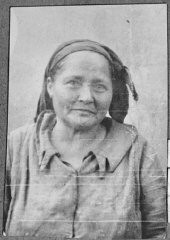
We would like to thank Crown Family Philanthropies, Abe and Ida Cooper Foundation, the Claims Conference, EVZ, and BMF for supporting the ongoing work to create content and resources for the Holocaust Encyclopedia. View the list of donor acknowledgement.